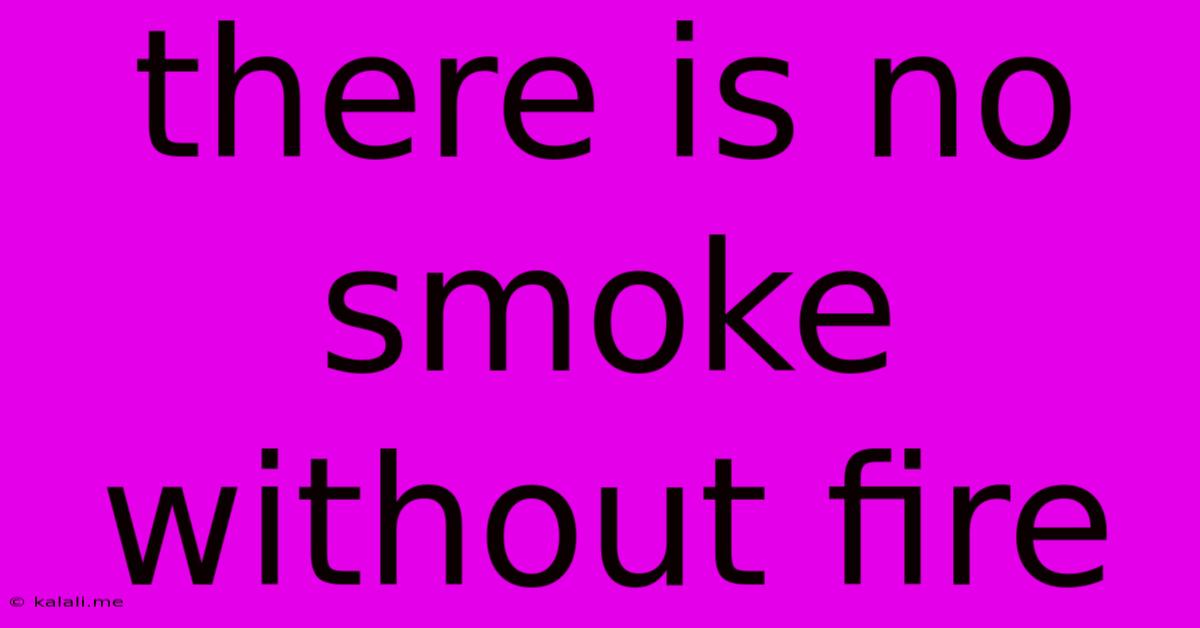There Is No Smoke Without Fire
Kalali
May 22, 2025 · 3 min read

Table of Contents
There's No Smoke Without Fire: Understanding the Proverb and its Modern Applications
The proverb "There's no smoke without fire" is a timeless adage that speaks to the underlying truth behind appearances. It suggests that rumors, suspicions, and visible signs of trouble rarely emerge from nothing. While not always literally true (think carefully planned smoke signals!), the proverb's core meaning points to a strong correlation between observable effects and underlying causes. This article will delve deeper into the meaning, explore its various applications, and examine the exceptions that prove the rule.
The proverb's power lies in its simplicity and immediate understanding. It serves as a warning to be cautious and investigate when presented with evidence of wrongdoing, even if that evidence is seemingly minor or circumstantial. It encourages critical thinking and a healthy skepticism, urging us to look beyond surface-level observations and probe for underlying reasons. A wisp of smoke, after all, often suggests a larger, hidden fire.
Deconstructing the Proverb: Literal and Figurative Meanings
The literal interpretation is straightforward: smoke is a visible byproduct of fire. You won’t see smoke billowing without some form of combustion happening nearby. This observable link forms the basis of the proverb’s metaphorical meaning.
Figuratively, "smoke" represents rumors, gossip, suspicions, or any visible sign of trouble or wrongdoing. The "fire" represents the underlying cause – the truth behind those outward manifestations. This could be anything from a genuine problem within an organization to a fabricated scandal deliberately spread to damage someone's reputation.
Modern Applications: Where the Proverb Holds True
The proverb remains relevant in various contexts today:
- Workplace Disputes: Persistent complaints about a colleague or manager likely point to underlying issues that need addressing. Ignoring the "smoke" (complaints) will only allow the "fire" (the actual problem) to fester and grow larger.
- Relationship Issues: Recurring arguments or signs of distance in a relationship often indicate deeper problems. Dismissing the early warning signs can lead to a much more significant crisis down the line.
- Financial Markets: Sudden drops in stock prices or unusual trading activity can be "smoke" signaling underlying problems within a company or the wider market. Investigating these signals is crucial for investors to protect their assets.
- Political Scandals: Rumors and allegations, however unsubstantiated initially, often indicate some truth or at least a cause for investigation. Ignoring the "smoke" can lead to larger cover-ups and loss of public trust.
- Social Media: The rapid spread of information, particularly on social media, often sees rumors and accusations spread like wildfire. While not every online rumor holds merit, the proverb serves as a reminder to approach such information with critical evaluation before jumping to conclusions.
Exceptions to the Rule: When Smoke is Just Smoke
While generally true, the proverb isn't foolproof. There are instances where "smoke" might appear without an actual "fire":
- Misinformation and False Accusations: Deliberate attempts to smear someone's reputation can create a smokescreen of allegations, even in the absence of any wrongdoing.
- Coincidence and Misinterpretation: Sometimes, seemingly related events are purely coincidental, leading to inaccurate conclusions. Jumping to conclusions based on limited evidence can lead to misinterpretations.
- Overly Sensitive Perceptions: Sometimes, individuals might perceive "smoke" where none exists due to heightened anxiety or paranoia.
Conclusion: The Importance of Investigation and Critical Thinking
The proverb "There's no smoke without fire" serves as a valuable reminder to approach situations with caution and skepticism. While not always literally true, the underlying message – to investigate potential problems and seek to understand underlying causes – remains crucial in navigating the complexities of life, work, and relationships. It's a call for critical thinking and a healthy dose of caution, reminding us that superficial appearances can be deceiving, and a deeper investigation is often needed to uncover the truth. The key is to discern genuine concerns from fabricated narratives, a skill crucial in today's rapidly evolving world filled with information overload.
Latest Posts
Latest Posts
-
What Is The Date Next Saturday
May 22, 2025
-
How To Train Cat To Poop Outside
May 22, 2025
-
How To Empty Hot Water Cylinder
May 22, 2025
-
Moving House With An Outdoor Cat
May 22, 2025
-
What Is A Round Trip Flight
May 22, 2025
Related Post
Thank you for visiting our website which covers about There Is No Smoke Without Fire . We hope the information provided has been useful to you. Feel free to contact us if you have any questions or need further assistance. See you next time and don't miss to bookmark.